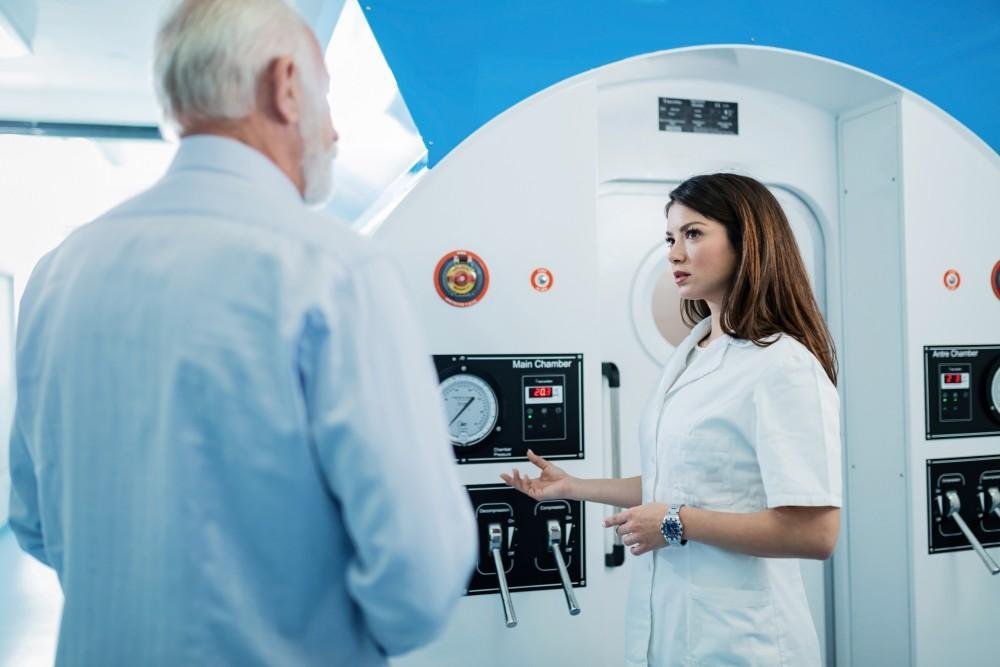For people with diabetes, foot ulcers pose serious health risks, including the risks of serious infections and amputations. Hyperbaric oxygen therapy can help, offering key benefits that aid in healing.
Most people know that diabetes affects the way your body uses glucose (blood sugar). But far fewer people know that diabetes can also affect your body’s ability to heal, resulting in deep foot sores called diabetic foot ulcers.
As many as a third of diabetes patients develop a diabetic foot ulcer, significantly increasing their risks of infection and lower limb amputation.
Because of the way diabetes affects your body, treating these sores can be very difficult, which means it’s especially important to seek advanced treatment as soon as possible.
Since diabetes interferes with normal healing, foot ulcers often don’t respond to typical wound care treatments, like antibiotic creams and bandages. Instead, they require advanced therapies to improve healing responses and reduce the risk of complications.
Manjulatha Badam, MD, CWSP, UHM, is a leading wound care specialist in San Antonio, Texas, helping patients at Vayu Advanced Wound Clinic and Hyperbarics get state-of-the-art therapies aimed at improving foot ulcer healing.
At her practice, many patients benefit from hyperbaric oxygen therapy (HBOT) for diabetic foot ulcers. This month, she explains how HBOT could help you.
Diabetes and your feet
Diabetes can damage both your nerves and your blood vessels, and combined, these damages are what ultimately can lead to foot ulcers.
Nerve damage in your feet means you may not notice tiny wounds and injuries, giving them time to fester. Problems with circulation mean healing can be delayed, allowing infections to take hold.
If you have diabetes, carefully examine your feet every day for unusual changes, and schedule a visit with us if you notice symptoms like:
- Tingling or numbness
- Pain or cramping in your feet or legs
- Electricity-like shocks or burning sensations
- Thick or discolored toenails
- Athlete’s foot or other infections
- Visible injuries, like blisters or sores
- Changes in skin color or temperature
During your visit, we evaluate your feet, review your medical history, discuss your diabetes treatment plan, and prescribe treatment to help heal existing wounds and help prevent future problems.
Benefits of HBOT for diabetic foot ulcers
Diabetic foot ulcers are serious, but fortunately, they often respond well to HBOT. HBOT floods your tissues with pure oxygen, a necessary component for tissue repair and regeneration. During therapy, you relax in a pressurized chamber and breathe normally while we pump oxygen in.
Supporting natural healing responses, HBOT offers several benefits, including these four.
Improves tissue oxygenation
As you inhale, the increased oxygen level improves lung absorption, sending more oxygen into your bloodstream. When the increased oxygen in your blood reaches your foot ulcer, it jumpstarts the healing process for faster healing.
Lowers the risk of infection
Increased oxygen also improves new tissue growth, which means wounds can close more quickly. The faster your ulcer closes with new, healthy tissue, the less risk you have of developing a serious, deep infection.
Reduces the risk of amputation
Limb amputations are necessary once an infection becomes so deep that it begins to kill off healthy tissue, including skin, bone, and surrounding tissues. By speeding healing and reducing the risk of infection, HBOT also reduces the risk of amputation.
Improves quality of life
As part of comprehensive wound therapy, HBOT can help you get back on your feet faster, so you can go back to enjoying the activities you love.
Make foot care a priority
If you have diabetes, never ignore any unusual symptoms that affect your feet, ankles, or toes. To learn more about HBOT and how it can play a role in treating your diabetic foot ulcers, call us at 210-651-1112 or book an appointment online today.

